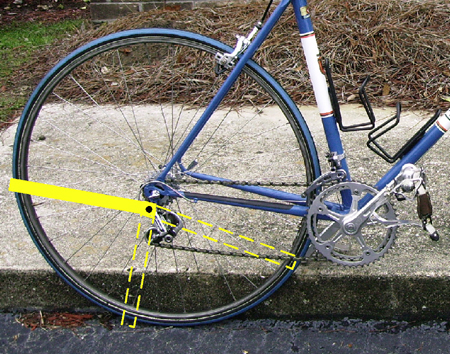Aligning a bent derailleur hanger
 Mon, November 22, 2010
Mon, November 22, 2010 
Someone contacted me recently with a bent derailleur hanger on a steel frame. It got bent when the chain jammed between the two front chainrings.
His local bike store was reluctant to attempt a straighten as there is a possibility it may break. I pointed out that the owner has nothing to lose if he attempted the job himself; if it breaks then it will have to go to a framebuilder to replace the complete dropout.
Here’s a simple homemade tool that will possibly straighten and at the same time correctly re-align the hanger. The thread on a gear hanger is 10mm x 1mm thread pitch. See if you can find a machine screw of this size that is 25mm in length, either hex head or Allen cap head will work.
If you can’t find such a screw, then use the actual derailleur hanger bolt; as long as it is steel and not aluminum.
From your local scrap steel yard, buy a piece of ¾ inch square steel bar. ¾ x 1 inch rectangle bar would also work. You could even use a piece of ¾ square steel tube as long as the wall thickness is at least 1/8 inch. Anything thinner would probably not be strong enough. This bar or tube needs to be 13 inches long.
If you managed to find a 10mm. x 1mm.p. x 25mm. screw, and have checked that it will fit in the hanger threads; Drill a 10mm. clearance hole (13/32 in.) 12 ½ inches from one end of the bar. You need to drill this in a drill press as it is important that the hole is square with the surface of the bar. A hand drill won’t cut it.
If you are going to use the derailleur hanger bolt, you will need to drill a 12mm. clearance hole. (31/64 in.) Also if this is the set up you have decided on, you will need two, thin, ½ inch flat steel washers to make up the thickness. In either case it is important that the bar bolts up tight to the face of the derailleur hanger.

Remove the derailleur from the hanger and disconnect the cable so you can move it completely out of the way. Remove the rear wheel, and either completely remove the chain, or at least let it hang out of the way, under the chainwheel.
Bolt the bar tightly to the derailleur hanger, and if it is badly bent, hold the dropout faces in a vise and use the bar to bend it straight, eyeballing it to an approximate degree of straightness.
Replace the rear wheel (Without the chain.) and tighten the quick release; make sure the wheel is central between the chainstays. Loosen the bar and swing it into one of the three positions shown in the top picture; tighten the bolt and take a measurement from the inside edge of the bar to the wheel rim.
Swing the bar to the next position and repeat. Make sure you tighten the hanger bolt each time and tweak the hanger using the bar as leverage. The hanger is in alignment when the bar to rim measurement is the same in all positions.
Ignore the fact that the top picture shows the derailleur and chain in place, I just used a stock photo to illustrate. If the difference between two opposite measurements is for example 1/4 inch, remember you will only need to tweak it 1/8 inch (Half the amount.) to correct it.
Inspect the hanger for cracks. If it does crack, the crack can be grooved out and tig welded; this would only cause a minimum damage to the paint. After welding, recheck the alignment as the heat may have moved it.
An improved version of this tool and one that a bike shop might like to have in their tool kit will need a machine shop’s assistance to produce.
A piece of ¾ diameter round steel bar approximately 12 inches long, is turned down and threaded 10 mm. x 1 mm. pitch at one end. This screws into the derailleur hanger and is actually used to bend it straight. A "T" handle at the opposite end to the thread to facilitate tightening by hand is a nice addition.
You still need a piece of flat bar with a 10 mm. hole in one end to act as a straight edge to measure to the rim, but this can be much lighter as it is not used for the actual bending; a piece of flat steel stock ¾ in. x 3/8 in. would work.
 Bike Tech
Bike Tech 





















Reader Comments (7)
Dave,
One point was overlooked, the material the hanger is made of. I will assume you refer to a Fuso style dropout/derailler hanger. Had the bike in question been a department store variety with stamped steel dropouts merely held in place by the seat and chainstays been pressed on, the steel is so mild that it can endure severe bending without fatigue. A conventional dropout will only take so much as you point out. I would be reluctant to attempt a derailler hanger realignment on a composite frame where the hanger is a bolt on component with your method. Ideally, replace the hanger but if you are determined to straighten it, take measurements as noted, remove the hanger from the frame, and place in a vice. This will require trial and error but won't impact a composite frame.
Checking out the alignment of a derailler hanger was standard procedure for us as it affects the shifting performance of the drivetrain. Even way back in the days of friction shifting, it was so. You would be amazed how many hangers are out of alignment even on new, higher end frames and bikes still on the showroom floor.
One final note. Derailler hanger alignment would have been the second step on a rear dropout. The first step would have been to check the dropouts themselves with dropout alignment tools.
Keep posting on the tech topics, they are always appreciated.
Thanks Jim,
You raise some good points, and yes I was referring to a steel frame. My point is if a derailleur hanger is bent, you either try to straighten it yourself or send to to a framebuilder to have the dropout replaced.
Therefore there is nothing to lose by attempting to straighten it yourself first. If it cracks and is properly tig welded, there is no reason that the repair won't last for many years.
Dave
Dave
I'd also rotate the wheel, so that the three plus measurements from the rim to the bar are always taken from the same point on the rim (e.g. the valve hole). That way, there would be no false differences to detected due to wobble in the wheel.
Dave, what is a "composite" frame? I have an aluminum touring frame with a replaceable dh that is bent; is it not safe to use this method to straighten it?
Great article!!
Mander,
A composite frame is carbon fiber. I don't recommend straightening aluminum, but if the derailleur hanger is replaceable can you get a replacement?
Dave
Thought so... will do. Thanks Dave!
This is a little old, but I just discovered this because I'm trying to advise a new friend that has an old Benotto with a RD that just got totally munched, so bad it looks like it got turned inside out, so I'm fairly sure the hanger will need to be straightened. Unfortunately, I don't have a drill press.
Any idea about how well it would work to, instead of drilling a hole in scrap steel, put the bolt through the hanging hole on the back end of a 13" crescent wrench? I assume with a couple sturdy washers on each side (like your headset press -- I love your homebrew solutions!!)